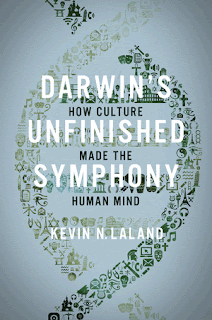 He applied the “Page 99 Test” to his book Darwin’s Unfinished Symphony: How Culture Made the Human Mind, and reported the following:
He applied the “Page 99 Test” to his book Darwin’s Unfinished Symphony: How Culture Made the Human Mind, and reported the following:Of all animals on Earth, humans alone sequence genomes, invent robots, devise drug treatments, and dance to Swan Lake. For biologists like myself, this discontinuity demands an evolutionary explanation. However, humans do not have a monopoly on creativity – animals invent new behaviour too. Now research into animal innovation is starting to explain the evolution of the human mind.Visit the Darwin’s Unfinished Symphony website.
Page 99 of Darwin’s Unfinished Symphony describes what is perhaps the most celebrated example of animal innovation. In 1921 in a small village on the south coast of England, a blue tit was first observed to peck open the foil top of a milk bottle to drink the cream. Over the next thirty years, the milk bottle top opening habit was observed to spread across towns and countryside until it eventually pervaded the whole of the UK and much of mainland Europe.
Milk bottle opening is one of many examples of animal innovation described in chapter 5 of my book. The inventions of other animals are highly diverse. For instance, orangutans devised means of extracting palm hearts from trees with vicious defenses, whilst herring gulls invented the habit of catching rabbits and killing them by drowning them at sea. Not all animals are equally inventive, and typically the more innovative a species the bigger its brain. The apes, capuchins and macaques are the primates that exhibit the greatest amounts of innovation, and these same species are the best tool users, have the broadest diets, and the most complex learning and cognition. The latest thinking is that these associations are no coincidence. Natural selection favouring the intelligence to devise and copy new opportunities was a driver of primate brain expansion.
Darwin’s Unfinished Symphony explains how the human mind—and the uniquely human ability to devise and transmit culture—evolved from its roots in animal behavior. Drawing on three decades of my own scientific research, I describe how the novel inventions and socially transmitted activities of our ancestors shaped our intellects through accelerating cycles of evolutionary feedback. The truly unique characteristics of our species—such as our intelligence, language, teaching, and cooperation—are not adaptive responses to predators, disease, or external conditions. Rather, humans are creatures of their own making. Runaway evolutionary feedback from our ancestors’ cultural activities accounts for our rise from scavenger apes in prehistory to modern humans able to design iPhones, dance the tango, and send astronauts into space.
--Marshal Zeringue



